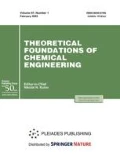Abstract
The scientific and technical problem of calculating the transfer of momentum, heat and mass of water vapor in cooling towers has been solved theoretically using a turbulent boundary layer model in the gas phase for irrigated packing blocks. A dissipative mathematical model for determining the average tangential friction stress at the gas–liquid interface in film contact devices (sprinkler blocks) with intensifiers is considered. On the basis of the average rate of dissipation of the energy of the gas flow in the sprinkler blocks with a given law of damping of turbulent pulsations in the boundary layer, expressions are obtained for calculating the average values at the interface of the shear stress and dynamic velocity necessary to calculate the coefficients of heat and mass transfer in the gas phase. To calculate the heat and mass transfer coefficients, expressions obtained earlier by the authors are used which are associated with the hydromechanical characteristics of a turbulent boundary layer. To determine the characteristics of the boundary layer with intensifiers on contact film devices, the properties of the conservatism of the laws of friction and heat transfer to perturbations are applied. Perturbations do not change the form of the mathematical description of the transfer of momentum and heat, and perturbations are taken into account parametrically. As a result, expressions are obtained for the Nusselt and Sherwood numbers for contact devices of various designs. Numerous comparisons of the results of calculating the coefficients of heat and mass transfer for chaotic and regular packings (sprinkler blocks) with known experimental data are shown. The expressions can be used in the calculations of sprinkler film blocks using hydraulic resistance, which reduces the time and costs in the design of cooling towers.





Similar content being viewed by others
REFERENCES
Sovershenstvovanie konstruktsii kontaktnykh ustroistv dlya gradiren (Improvement of the Designs of Contact Devices for Cooling Towers), Pushnov, A.S. and Sakalauskas, A., Eds., St. Petersburg: Politekh-Press, 2020.
Zhavoronkov, N.M., Teoreticheskie osnovy khimicheskoi tekhnologii: izbrannye trudy (Theoretical Foundations of Chemical Engineering: Selected Works), Moscow: Nauka, 2007.
Ponomarenko, V.S. and Aref’ev, Yu.I., Gradirni promyshlennykh i energeticheskikh predpriyatii (Cooling Towers in Industrial and Energy Plants), Moscow: Energoatomizdat, 1998.
Vitkovskaya, R.F., Pushnov, A.S., and Shinkunas, S., Aerogidrodinamika i teplomassoobmen nasadochnykh apparatov (Aerohydrodynamics and Heat and Mass Transfer in Packed Apparatuses), St. Petersburg: Lan’, 2019.
Gorodilov, A.A., Pushnov, A.S., and Berengarten, M.G., Intensification methods for heat and mass transfer processes in regular packing, Energosberezhenie Vodopodgot., 2014, no. 3 (89), p. 45.
Voinov, N.A., and Nikolaev, N.A., Teploobmen pri plenochnom techenii zhidkosti (Heat Transfer in the Film Flow of Liquids), Kazan: Otechestvo, 2011.
Laptev, A.G., Basharov, M.M., Lapteva, E.A., and Farakhov, T.M., Modeli i effektivnost’ protsessov mezhfaznogo perenosa. Chast’ 2. Teplomassoobmennye protsessy (Models and Efficiency of Interphase Transfer Processes, vol. 2: Heat and Mass Transfer Processes), Kazan: Tsentr Innovats. Tekhnol., 2020.
Laptev, A.G., Farakhov, T.M., and Basharov, M.M., A mathematical model of local and average heat transfer in channels with heat transfer intensifiers, Therm. Eng., 2019, vol. 66, no. 8, pp. 580–586. https://doi.org/10.1134/S0040601519080044
Nazmeev, Yu.G., Teploobmen pri laminarnom techenii zhidkosti v diskretno-sherokhovatykh kanalakh (Heat Transfer in the Laminar Flow of Liquids in Discretely Rough Channels), Moscow: Energoatomizdat, 1998.
Isaev, S.I., Kozhinov, I.A., Kofanov, V.I., Leont’ev, A.I., Mironov, B.M., Nikitin, V.M., Petrazhitskii, G.B., Khvostov, V.I., Chukaev, A.G., Shishov, E.V., and Shkola, V.V., Teoriya teplomassoobmena. Uchebnik dlya vuzov. Seriya “Tekhnicheskaya fizika i energomashinostroenie” (The Theory of Heat and Mass Transfer: A Textbook for Institutions of Higher Education, Series in Technical Physics and Power Plant Engineering), Moscow: Mosk. Gos. Tekh. Univ. im. N. E. Baumana, 2018.
Landau, L.D. and Lifshitz, E.M., Teoreticheskaya fizika: uchebnoe posobie v 10 tomakh. T. 6. Gidrodinamika (Theoretical Physics: A Textbook in Ten Volumes, vol. 6: Hydrodynamics), Moscow: Nauka, 2017.
Repik, E.U. and Sosedko, Yu.P., Turbulentnyi pogranichnyi sloi. Metodika i rezul’taty eksperimentov issledovanii (Turbulent Boundary Layer: Procedure and Results of Experimental Studies), Moscow: Fizmatlit, 2007.
Ramm, V.M., Absorbtsiya gazov (Gas Absorption), Moscow: Khimiya, 1976, 2nd ed.
Laptev, A.G., Farakhov, T.M., and Lapteva, E.A., Models of transport phenomena in random packed and granular beds, Theor. Found. Chem. Eng., 2015, vol. 49, no. 4, pp. 388–395. https://doi.org/10.1134/S0040579515040296
Kutateladze, S.S. and Leont’ev, A.I., Teplomassoobmen i trenie v pogranichnom sloe (Heat and Mass Transfer and Friction in the Boundary Layer), Moscow: Energiya, 1985.
D’yakonov, S.G., Elizarov, V.V., and Elizarov, V.I., Teoreticheskie osnovy proektirovaniya promyshlennykh apparatov khimicheskoi tekhnologii na baze sopryazhennogo fizicheskogo i matematicheskogo modelirovaniya (Theoretical Fundamentals of the Design of Industrial Apparatuses in Chemical Technology Using Conjugated Physical and Mathematical Modeling), Kazan: Kazan. Gos. Tekhnol. Univ., 2009.
Blinichev, V.N., Komlev, V.G., Zakharov, V.M., et al., Study of resistance coefficients and heat transfer coefficients in a packed bed, Izv. Vyssh. Uchebn. Zaved., Khim. Khim. Tekhnol., 1987, vol. 30, no. 2, p. 124.
Laptev, A.G. and Ved’gaeva, I.A., Ustroistvo i raschet promyshlennykh gradiren (Design and Calculation of Industrial Cooling Towers), Kazan: Kazan. Gos. Energ. Univ., 2004.
Kagan, A.M., Laptev, A.G., Pushnov, A.S., and Farakhov, M.I., Kontaktnye nasadki promyshlennykh teplomassoobmennykh apparatov (Packing Elements for Industrial Heat and Mass Transfer Apparatuses), Kazan: Otechestvo, 2013.
Funding
This study was carried out as part of the Russian Science Foundation, research project no. 18-79-101-36.
Author information
Authors and Affiliations
Corresponding author
Rights and permissions
About this article
Cite this article
Laptev, A.G., Lapteva, E.A. Mathematical Models of Friction on the Surface of Phase Separation and Heat and Mass Transfer in Film Units of Cooling-Tower Sprinklers with Intensifiers. Theor Found Chem Eng 55, 906–913 (2021). https://doi.org/10.1134/S0040579521050250
Received:
Revised:
Accepted:
Published:
Issue Date:
DOI: https://doi.org/10.1134/S0040579521050250



